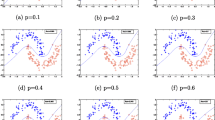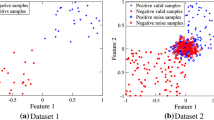Abstract
The least square twin support vector machine (LS-TSVM) obtains two non-parallel hyperplanes by directly solving two systems of linear equations instead of two quadratic programming problems (QPPs) as in the conventional twin support vector machine (TSVM), which makes the computational speed of LS-TSVM faster than that of the TSVM. However, LS-TSVM ignores the structural information of data which may contain some vital prior domain knowledge for training a classifier. In this paper, we apply the prior structural information of data into the LS-TSVM to build a better classifier, called the structural least square twin support vector machine (S-LSTSVM). Since it incorporates the data distribution information into the model, S-LSTSVM has good generalization performance. Furthermore, S-LSTSVM costs less time by solving two systems of linear equations compared with other existing methods based on structural information. Experimental results on twelve benchmark datasets demonstrate that our S-LSTSVM performs well. Finally, we apply it into Alzheimer’s disease diagnosis to further demonstrate the advantage of our algorithm.

Similar content being viewed by others
References
Vapnik V (1995) The nature of statistical learning theory. Springer, New York
Cristianini N, Shawe-Taylor J (2000) An introduction to support vector machines and other kernel-based learning methods. Cambridge university press, Cambridge
Shawe-Taylor J, Cristianini N (2004) Kernel methods for pattern analysis. Cambridge university press, Cambridge
Yeung D, Wang D, Ng W (2007) Structured large margin machines: sensitive to data distributions. Mach Learn 68(2):171–200
Ward J (1963) Hierarchical grouping to optimize an objective function. J Am Stat Assoc 58(301):236–244
Xue H, Chen S, Yang Q (2011) Structural regularized support vector machine: a framework for structural large margin classifier. Neural networks. IEEE Trans 22(4):573–587
Jayadeva KR, Chandra S (2007) Twin support vector machines for pattern classification. IEEE Trans Pattern Anal Mach Intellegence 29:905–910
Qi Z, Tian Y, Shi Y (2013) Structural twin support vector machine for classification. Knowl-Based Syst 43:74–81
Arun Kumar M, Gopal M (2009) Least squares twin support vector machines for pattern classification. Expert Syst Appl 36(4):7535–7543
Xu Y, Xi W, Lv X (2012) An improved least squares twin support vector machine. J. Inf & Comput Sci 9:1063–1071
Shao Y, Zhang C, Wang X (2011) Improvements on twin support vector machines. Neural networks. IEEE Trans 22(6):962–968
Hartigan JA, Wong MA (1979) Algorithm AS 136: A k-means clustering algorithm. J R Stat Soc: Ser C: Appl Stat 28(1):100–108
Lu S, Fu K (1978) A sentence-to-sentence clustering procedure for pattern analysis. Systems, man and cybernetics. IEEE Trans 8(5):381–389
Zadeh L (1965) Fuzzy sets. Inform Control 8(3):338–353
El-Hamdouchi A, Willett P (1989) Comparison of hierarchic agglomerative clustering methods for document retrieval. The Comput J 32(3):220–227
Salvador S, Chan P (2004) Determining the number of clusters/segments in hierarchical clustering/segmentation algorithms//Tools with Artificial Intelligence. In: 16th IEEE International Conference on IEEE, pp 576-584
Smola A (2001) Learning with kernels: support vector machines, regularization, optimization, and beyond (Adaptive computation and machine learning)[J]
Golub G, Van Loan C (1996) Matrix computations, 3rd ed. The Johns Hopkins University Press, Baltimore
Xu Y, Guo R (2014) An improved v-twin support vector machine. Appl Intell 41(1):42–54
Xu Y, Wang L, Zhong P (2012) A rough margin-based ν-twin support vector machine. Neural Comput & Applic 21:1307–1317
Xu Y, Wang L (2014) K-nearest neighbor-based weighted twin support vector regression. Appl Intell 41(1):299–309
Dems̆ar J (2006) Statistical comparisons of classifiers over multiple data sets. J Mach Learn Res 7:1–30
García S, Fernández A, Luengo J, Herrera F (2010) Advanced nonparametric tests for multiple comparisons in the design of experiments in computational intelligence and data mining. Experimental analysis of power. Inf Sci 180:2044–2064
Li H , Liu Y , Gong P (2014) Hierarchical nteractions Model for Predicting Mild Cognitive Impairment (MCI) to Alzheimers Disease (AD) Conversion. Plos9(1)
Ye J, Farnum M, Yang E (2012) Sparse learning and stability selection for predicting MCI to AD conversion using baseline ADNI data. BMC Neurol 12:46
Wang L, Xu Y, Zhao L (2005) A kind of hybrid classification algorithm based on rough set and support vector machine. In: Proceedings of the fourth International Conference on Machine Learning and Cybernetics (ICMLC), pp 1676-1679
Xu Y, Zhen L et al. (2009) Classification algorithm based on feature selection and samples selection. Lect Notes Comput Sci 5552:631–638
Tibshirani R (1996) Regression shrinkage and selection via the Lasso. J of the Royal Stat Soc Ser B 58(1):267–288
Acknowledgments
The authors gratefully acknowledge the helpful comments and suggestions of the reviewers, which have improved the presentation. This work was supported in part by National Natural Science Foundation of China (No. 61153003), China Scholarship Fund (No. 201208110282), and Chinese Universities Scientific Fund (No. 2014QJ003).
Author information
Authors and Affiliations
Corresponding author
Rights and permissions
About this article
Cite this article
Xu, Y., Pan, X., Zhou, Z. et al. Structural least square twin support vector machine for classification. Appl Intell 42, 527–536 (2015). https://doi.org/10.1007/s10489-014-0611-4
Published:
Issue Date:
DOI: https://doi.org/10.1007/s10489-014-0611-4




